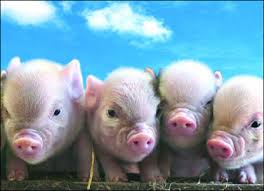To have a well-developed understanding of the species of the modern domestic pig, or Sus Scrofa Domesticus, one must not only explore the pig’s history, but also its behavioral patterns; in other words, its ethology. Beyond the brief description of pig and other successfully domesticated animals’ common behavioral characteristics provided in the previous section of this study, here is a general overview of the ins and outs of life as a pig.
-
social groupings (Gonyou 148-150)
-
2 to 4 sows (female pig), their most recent litters, and juvenile offspring of the most recent litter
-
sows are dominant
-
-
babies leave at 7-8 MOA, then eventually the boars (males) isolate themselves
-
males from different sounders (the families) are “mutually intolerant of each other” ( Gzrimeck 285)
-
communication (Gonyou 151)
-
boars mark territory with an odor
-
pheromones released through saliva to attract the mate
-
“grunts, snarls, and snorts”- pigs have a keen sense of hearing and pay close attention to this form of communication
-
-
intelligence (Angier)
-
can learn new tricks very quickly
-
forget things slowly
-
-
Pigs proved overall easy to domesticate. They have many similarities to humans, including the fact that their hearts metabolize drugs the same as humans (Angier). Little similarities such as these make pigs desirable as a domesticated animal even in the modern, highly technological world because they hold the potential to serve as stand ins for human biological processes, but that topic will be described in further detail towards the end of the study…
After learning a brief history of the pig’s contact with humans, as well as common behaviors in pigs, one may wonder how exactly the pig has impacted humans in the long run.
Overall, the domestication of animals for agriculture either results in nomadic tribes following their animal’s food source; or rather, it resulted in the opposite scenario where families intentionally stayed idle in order to form a lifestyle around their livestock. The domestication of the pig specifically, resulted in the second scenario, where families decided they had a better chance of survival if they stayed in one location and raised the pigs to provide for the family.
Furthermore, as previously mentioned, the domestication of animals for agriculture did in fact result in widespread disease (Butler). It is evident that the impact of the domestication of pigs follows a general pattern of consequences that the domestication of a farm animal will often produce. Pigs specifically served not only as a source of food, but as religious relics, street clean-up services, and overall intelligent multi-purpose companions.

No Comments Yet